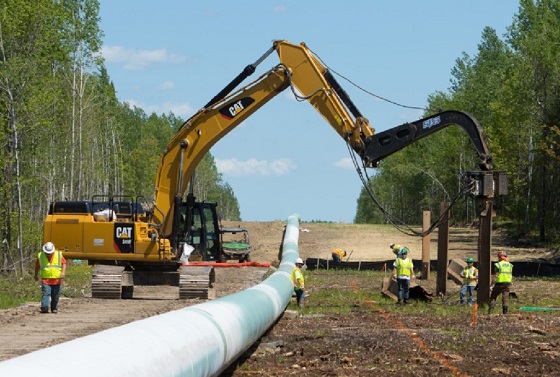Energy
Energy Policies Based on Reality, Not Ideology, are Needed to Attract Canadian ‘Superpower’ Level Investment – Ron Wallace

From Energy Now
By Ron Wallace
Get the Latest Canadian Focused Energy News Delivered to You! It’s FREE: Quick Sign-Up Here
OPEC Secretary-General Haitam Al Ghais recently delivered a message in Alberta that energy policies should be “based on reality, not ideology.” These comments are particularly relevant to Canada given the history of the past decade and the future policy path being proposed by the Carney government. Secretary Al Ghais cited studies from the IEA that noted in the past decade global investment in “clean energy” has approached $17 trillion with the result that renewable sources currently supply less than 4% of the world’s energy. Meanwhile, initiatives such as the introduction of EV’s, which apparently continues as a priority policy for Canada, have reached a total global penetration rate of less than 4% as electric cars are increasingly losing their appeal among new drivers in Western nations.
Considering an annual estimated cost of USD $640 billion required to maintain and secure global energy sources, the Secretary-General stressed the importance of “consistent messaging” for capital investment markets as they prepare to meet future energy demands through to 2050. By that time OPEC foresees oil and gas comprising more than 53% of the global energy mix with predictions that global oil demand will rise to more than 120 million barrels per day (mb/d) from the104 mb/d today. As for Alberta, he noted:
“Alberta’s success fits with the inclusive all-energies, all-technologies and all-peoples energy futures that OPC continues to advocate for – one based on realities, not ideologies such as unrealistic net zero targets that fixated on deadlines and dismissed certain energies.”
These words are highly relevant for Alberta and Canada, coming precisely at a time when the Federal government is debating new legislation (Bill C-5) that seeks to accelerate regulatory processes for selected projects. It remains to be seen if this approach will lead to heightened co-operation between Federal and provincial governments.
Federal aspirations, largely focused on Natural Resources Minister Tim Hodgson will quickly be tested by an increasingly impatient Alberta government that has announced plans to entice a private-sector player to build a major crude pipeline to coastal waters. In that regard, Premiers from Alberta and Saskatchewan are increasingly advocating for the repeal of policies like the West Coast tanker ban and net-zero electricity regulations, as they press for the development of defined energy corridors to access tidewaters noting that: “The federal government must remove the barriers it created and fix the federal project approval processes so that private sector proponents have the confidence to invest.” As Premier Moe has argued, if Canada scrapped policies such as proposed caps on oil and gas emissions Saskatchewan, which is currently Canada’s second-largest oil-producing province, could double its annual oil production.
It is more than ironic that controversial legislation currently being fast-tracked through the House (Bill C-5) effectively admits that the raft of Acts and Regulations enacted under the Trudeau government constitute material barriers to national development. The federal government, instead of repealing, or substantially amending that legislation some of which is being challenged, has received tough love from the Supreme Court, instead proposes to give Cabinet the power to suspend the IAA and several other key Acts in order to speed the process of issuing development applications and permits. By not doing the heavy lifting in Parliament needed to repeal or modify the burdensome legislative mandates enacted over the past decade, Carney’s remarkable approach instead chooses to circumvent that legislative base with the arbitrary suspensions of selected laws.
Meanwhile, Bill C-5 has received attention from parliamentarians and Indigenous communities. Former Trudeau-era Justice Minister Wilson-Raybould has commented that Bill C-5 has been developed “behind closed doors” to allow the federal government to “make decisions and build projects on its own terms, at its own pace and based on rules that it choses to make up as they go along.” Their concern is that the proposed law would give unprecedented powers to the federal cabinet to fast-track projects that the Cabinet defines as being in “national interest” allowing them to sidestep Canadian laws such as the Indian Act, Fisheries Act, Migratory Birds Convention Act and Canadian Environment Protection Act. Assumptions that the Act is being designed to facilitate oil and gas, as opposed to renewable energy, projects remain to be seen.
Recall that there remains long-simmering federal-provincial tensions rooted in jurisdictional disputes over the Impact Assessment Act (IAA) (or Bill C-69) which the Supreme Court of Canada (SCC) ruled as having parts that constituted an unconstitutional, “impermissible intrusion“ federal overreach into provincial jurisdiction. Subsequently, the Federal Court overturned Canada’s ban on single-use plastic having deemed that policy to be “unreasonable and unconstitutional”. The federal Clean Electricity Regulations (published in November 2024) are strongly opposed by Alberta which in April 2025 filed a reference case with the Alberta Court of Appeal to challenge the constitutionality of those Regulations with arguments that Canada’s constitution under Section 92A grants exclusive jurisdiction to the province for the generation and production of electrical energy.
Instead of providing regulatory and investment certainty the federal government has chosen to advance Bill C-5 that introduces more, not less, uncertainty into the Canadian energy development and regulatory process. One should ask: Does a process designed to over-ride existing laws and statutes operated by a closed Cabinet that reaches decisions based on “criteria” set by Ottawa, provide enhanced investment certainty for proponents of major energy projects?
Alternatively, would it not be better to amend or repeal existing, punitive federal laws and regulations, starting with those that are presently being actively challenged by the provinces in the courts? Canada needs to ask itself if, with this legislation, we will achieve the “consistent messaging” required to attract the capital investment for energy projects as was highlighted by the Secretary-General.
Ron Wallace is a former Member of the National Energy Board.
Energy
75 per cent of Canadians support the construction of new pipelines to the East Coast and British Columbia

-
71 per cent of Canadians find the approval process too long.
-
67 per cent of Quebecers support the Marinvest Energy natural gas project.
“While there has always been a clear majority of Canadians supporting the development of new pipelines, it seems that the trade dispute has helped firm up this support,” says Gabriel Giguère, senior policy analyst at the MEI. “From coast to coast, Canadians appreciate the importance of the energy industry to our prosperity.”
Three-quarters of Canadians support constructing new pipelines to ports in Eastern Canada or British Columbia in order to diversify our export markets for oil and gas.
This proportion is 14 percentage points higher than it was last year, with the “strongly agree” category accounting for almost all of the increase.
For its part, Marinvest Energy’s natural gas pipeline and liquefaction plant project, in Quebec’s North Shore region, is supported by 67 per cent of Quebecers polled, who see it as a way to reduce European dependence on Russian natural gas.
Moreover, 54 per cent of Quebecers now say they support the development of the province’s own oil resources. This represents a six-point increase over last year.
“This year again, we see that this preconceived notion according to which Quebecers oppose energy development is false,” says Mr. Giguère. “Quebecers’ increased support for pipeline projects should signal to politicians that there is social acceptability, whatever certain lobby groups might think.”
It is also the case that seven in ten Canadians (71 per cent) think the approval process for major projects, including environmental assessments, is too long and should be reformed. In Quebec, 63 per cent are of this opinion.
The federal Bill C-5 and Quebec Bill 5 seem to respond to these concerns by trying to accelerate the approval of certain large projects selected by governments.
In July, the MEI recommended a revision of the assessment process in order to make it swift by default instead of creating a way to bypass it as Bill C-5 and Bill 5 do.
“Canadians understand that the burdensome assessment process undermines our prosperity and the creation of good, well-paid jobs,” says Mr. Giguère. “While the recent bills to accelerate projects of national interest are a step in the right direction, it would be better simply to reform the assessment process so that it works, rather than creating a workaround.”
A sample of 1,159 Canadians aged 18 and older were surveyed between November 27 and December 2, 2025. The results are accurate to within ± 3.5 percentage points, 19 times out of 20.
Business
Geopolitics no longer drives oil prices the way it used to

This article supplied by Troy Media.
Oil markets are shrugging off war and sanctions, a sign that oversupply now matters more than disruption
Oil producers hoping geopolitics would lift prices are running into a harsh reality. Markets are brushing off wars and sanctions as traders focus instead on expectations of a deep and persistent oil glut.
That shift was evident last week. Despite several geopolitical developments that would once have pushed prices higher, including the U.S. seizure of a Venezuelan crude tanker and fresh Ukrainian strikes on Russian energy infrastructure, oil markets barely reacted, with prices ending the week lower.
Brent crude settled Friday at US$61.12 a barrel and U.S. West Texas Intermediate at US$57.44, capping a weekly drop of more than four per cent.
Instead of responding to disruption headlines, markets were reacting to a different risk. Bearish sentiment, rather than geopolitics, continued to dominate as expectations of a “2026 glut” took centre stage.
At the heart of that outlook is a growing supply overhang. The oil market is grappling with whether sanctioned Russian and Iranian cargoes should still be counted as supply. That uncertainty helps explain why prices have been slow to react to a glut that is already forming on the water, said Carol Ryan, writing for The Wall Street Journal.
The scale of that buildup is significant. There are 1.4 billion barrels of oil “on the water,” 24 per cent higher than the average for this time of year between 2016 and 2024, according to oil analytics firm Vortexa. These figures capture shipments still in transit or cargoes that have yet to find a buyer, a clear sign that supply is running ahead of immediate demand.
Official forecasts have reinforced that view. Last week, the International Energy Agency trimmed its projected 2026 surplus to 3.84 million barrels per day, down from 4.09 million barrels per day projected previously. Even so, the IEA still sees a large oversupply relative to global demand.
Demand growth offers little relief. The IEA expects growth of 830 kb/d (thousand barrels per day) in 2025 and 860 kb/d in 2026, with petrochemical feedstocks accounting for a larger share of incremental demand. That pace remains modest against the volume of supply coming to market.
OPEC, however, has offered a different assessment. In its latest report, the group pointed to a near balance, forecasting demand for OPEC+ crude averaging about 43 million barrels per day in 2026, roughly in line with what it produced in November.
Reflecting that confidence. OPEC+ kept policy steady late in November, pausing planned output hikes for the first quarter of 2026 while more than three million barrels per day of cuts remain in place. Those measures are supportive in theory, but markets have shown little sign of being persuaded.
Recent geopolitical events underline that scepticism. The ongoing Russia-Ukraine war and Ukrainian strikes on Russian energy infrastructure, including reported hits on facilities such as the Slavneft-YANOS refinery in Yaroslavl, again failed to lift prices. Russia-Ukraine headlines pulled prices down more than strikes lifted them, according to media reports, suggesting traders were more attuned to “peace deal” risk than to supply disruption.
Washington’s move against Venezuelan crude shipments offered another test. The U.S. seizure of a Venezuelan tanker, the first formal seizure under the 2019 sanctions framework, had a muted price impact, writes Marcin Frackiewicz of Oilprice.com.
Venezuela’s exports fell sharply in the days that followed, but markets remained largely unmoved. One explanation is that Venezuela’s output is no longer large enough to tighten global balances the way it once did, and that abundant global supply has reduced the geopolitical premium.
Taken together, the signal is hard to miss. Oil producers, including in Canada, face a reality check in a market that no longer rewards headlines, only discipline and demand.
Toronto-based Rashid Husain Syed is a highly regarded analyst specializing in energy and politics, particularly in the Middle East. In addition to his contributions to local and international newspapers, Rashid frequently lends his expertise as a speaker at global conferences. Organizations such as the Department of Energy in Washington and the International Energy Agency in Paris have sought his insights on global energy matters.
Troy Media empowers Canadian community news outlets by providing independent, insightful analysis and commentary. Our mission is to support local media in helping Canadians stay informed and engaged by delivering reliable content that strengthens community connections and deepens understanding across the country.
-

 Health2 days ago
Health2 days agoFDA warns ‘breast binder’ manufacturers to stop marketing to gender-confused girls
-

 Uncategorized1 day ago
Uncategorized1 day agoMortgaging Canada’s energy future — the hidden costs of the Carney-Smith pipeline deal
-

 Agriculture2 days ago
Agriculture2 days agoSupply Management Is Making Your Christmas Dinner More Expensive
-

 International2 days ago
International2 days ago2025: The Year The Narrative Changed
-

 Business2 days ago
Business2 days agoThere’s No Bias at CBC News, You Say? Well, OK…
-

 Daily Caller2 days ago
Daily Caller2 days agoTrump Reportedly Escalates Pressure On Venezuela With Another Oil Tanker Seizure
-

 International1 day ago
International1 day agoAustralian PM booed at Bondi vigil as crowd screams “shame!”
-

 Opinion1 day ago
Opinion1 day agoReligion on trial: what could happen if Canada passes its new hate speech legislation











